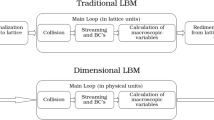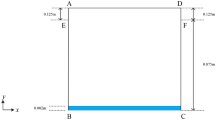Abstract
This paper is a prequel to that of Marchand et al. (Comput Geosci 16:691–708, 2012), where an efficient and accurate hybrid-mixed finite element approximation for a system of time-dependent nonlinear conservation equations has been formulated, implemented, and tested, which are general enough to represent most of the existing formulations for two-component liquid–gas flow in porous medium with phase exchange, also allowing for any (dis)appearance of one of the phases. Temperature variation is neglected, but capillary effects are included by extended Darcy’s law, and Fickian diffusion is taken into account. The efficiency and stability of the numerical method of Lake (1989) relies on an equivalent reformulation of the otherwise commonly used model in terms of new principal variables and subsequent static (flash) equations allowing more generally for any (dis)appearance of one of the phases without the need of variable switching or unphysical quantities. In particular, the formulation in terms of complementarity conditions allows for an efficient and stable solution by the semismooth Newton’s method.
Similar content being viewed by others
References
Abadpour, A., Panfilov, M.: Method of negative saturations for modeling two-phase compositional flow with oversaturated zones. Transp. Porous Media 79, 197–214 (2009)
Angelini, O., Chavant, C., Chénier, E., Eymard, R., Granet, S.: Finite volume approximation of a diffusion–dissolution model and application to nuclear waste storage. Math. Comput. Simul. 81(10), 2001–2017 (2010)
Battino, R., Clever, H.L.: The solubility of gases in liquids. Chem. Rev. 66(4), 395–463 (1966)
Bear, J., Verruijt, A.: Modeling Groundwater Flow and Pollution. Reidel, Asmterdam (1987)
Ben Gharbia, I., Gilbert, J.: Nonconvergence of the plain Newton-min algorithm for linear complementarity problems with a P-matrix. Math. Program. (2011). doi:10.1007/s10107-010-0439-6
Ben Gharbia, I., Jaffré, J.: Gas phase appearance and disappearance as a problem with complementarity constraints. Math. Comput. Simul. (2013, in press). URL: http://arxiv.org/abs/1111.3808
Bird, W.E., Lightfoot, E.N.: Transport Phenomena. Second Edition. Wiley, New York (2002)
Bourgeat, A., et al.: Numerical test data base. URL: http://momas.univ-lyon1.fr/cas_test.html. Accessed 6 Feb 2013
Bourgeat, A., Jurak, M., Smaï, F.: Two-phase, partially miscible flow and transport modeling in porous media: application to gas migration in a nuclear waste repository. Comput. Geosci. 13(1), 29–42 (2009)
Bourgeat, A., Jurak, M., Smaï, F.: Modelling and numerical simulation of gas migration in a nuclear waste repository (2010). URL: http://arxiv.org/abs/1006.2914
Bourgeat, A.P., Granet, S., Smaï, F.: Compositional two-phase flow in saturated-unsaturated porous media: benchmarks for phase appearance/disappearance (2012, in press)
Buchholzer, H., Kanzow, C., Knabner, P., Kräutle, S.: The semismooth Newton method for the solution of reactive transport problems including mineral precipitation–dissolution reactions. Comput. Optim. Appl. 50, 193–221 (2011)
Chavent, G., Jaffré, J.: Mathematical Models and Finite Elements for Reservoir Simulation. North Holland, Amsterdam (1986)
Class, H., Helmig, R., Bastian, P.: Numerical simulation of nonisothermal multiphase multicomponent processes in porous media 1. An efficient solution technique. Adv. Water Resour. 25, 533–550 (2002)
Class, H., Dahle, H.K., Helmig, R. (guest eds.): Special issue: numerical models for carbon-dioxide storage in geological formations. Comput. Geosci. 13(4), 405–509 (2009)
Class, H., Ebigbo, A., Helmig, R., Dahle, H.K., Nordbotten, J.M., Celia, M.A., Audigane, P., Darcis, M., Ennis-King, J., Fan, Y., Flemisch, B., Gasda, S.E., Jin, M., Krug, S., Labregere, D., Beni, A.N., Pawar, R.J., Sbai, A., Thomas, S.G., Trenty, L., Wei, L.: A benchmark study on problems related to CO2 storage in geologic formations. Summary and discussion of the results. Comput. Geosci. 13, 409–434 (2009)
Darcy, H.: Détermination des lois d’écoulement de l’eau à travers le sable. In: Les Fontaines Publiques de la Ville de Dijon. V. Dalmont, Paris (1856). Appendice—Note D
Deuflhard, P.: Newton methods for nonlinear problems. In: Springer Series in Computational Mathematics. Springer, Berlin (2004)
Ern, A., Mozolevski, I.: Discontinuous Galerkin method for two-component liquid–gas porous media flows. Comput. Geosci. 16, 677–690 (2012)
Gasmi, C.F., Voskov, D.V., Tchelepi, H.A.: A new method for thermodynamic equilibrium computation of systems with an arbitrary number or phases. In: SPE Reservoir Simulation Symposium, SPE 119060 (2009)
Ho, C.K., Webb, S.W. (eds.): Gas Transport in Porous Media. Springer, New York (2006)
Hou, M.Z., Xie, H., Yoon, J. (eds.): Underground Storage of CO2 and Energy. Balkema, Rotterdam (2010)
Ito, K., Kunish, K.: On a semi-smooth Newton method and its globalization. Math. Program. Ser. A 118, 347–370 (2009)
Jaffré, J., Sboui, A.: Henry’s law and gas phase disappearance. Transp. Porous Media 82, 521–526 (2010)
Knabner, P., van Duijn, C.J., Hengst, S.: An analysis of crystal dissolutions fronts of flows through porous media. Part 1: Compatible boundary conditions. Adv. Water Resour. 18, 171–185 (1995)
Kräutle, S.: General multi-species reactive transport problems in porous media: efficient numerical approaches and existence of global solutions. Chapter 4: reactions with minerals: a complementarity problem solved by the semismooth Newton method (2008). URL: http://www1.am.uni-erlangen.de/~kraeutle/habil.pdf. Habilitationsschrift
Kräutle, S.: The semismooth Newton method for multicomponent reactive transport with minerals. Adv. Water Resour. 34(1), 137–151 (2011)
Krishna, R., Wesselingh, J.A.: The Maxwell–Stefan approach to mass transfer. Chem. Eng. Sci. 52(6), 861–911 (1997)
Lake, L.W.: Enhanced Oil Recovery. Prentice-Hall, Englewood Cliffs (1989)
Landau, L.D., Lifshitz, E.M.: Statistical Physics Part 1. Pergamon, New York (1959)
Lauser, A., Hager, C., Helmig, R., Wohlmuth, B.: A new approach for phase transitions in miscible multi-phase flow in porous media. Adv. Water Resour. 34, 957–966 (2011)
Marchand, E., Müller, T., Knabner, P.: Fully coupled generalised hybrid-mixed finite element approximation of two-phases two-components flow in porous media. Part II: numerical scheme and numerical results. Comput. Geosci. 16, 691–708 (2012)
Michelsen, M.L.: The isothermal flash problem. Part II. Phase-split calculation. Fluid Phase Equilib. 9, 21–40 (1982)
Neumann, R., Bastian, P., Ippisch, O.: Modeling and simulation of two-phase two-component flow with disappearing nonwetting phase. Comput. Geosci. (2012). doi:10.1007/s10596-012-9321-3
Orr, F.M. Jr., Jessen, K.: An analysis of the vanishing interfacial tension technique for determination of minimum miscibility pressure. Fluid Phase Equilib. 255, 99–109 (2007)
Otto, F.: L1-contraction and uniqueness for quasilinear elliptic-parabolic equations. J. Differ. Equ. 131, 20–38 (1996)
Panfilov, M., Rasoulzadeh, M.: Interfaces of phase transition and disappearance and method of negative saturation for compositional flow with diffusion and capillarity in porous media. Transp. Porous Media 83, 73–78 (2010)
Shapiro, A.A., Stenby, E.H.: Thermodynamics of the multicomponent vapor–liquid equilibrium under capillary pressure difference. Fluid Phase Equilib. 178, 17–32 (2001)
Smaï, F.: Développement d’outils mathématiques et numériques pour l’évaluation du concept de stockage géologique. Ph.D. thesis, Université de Lyon (2009)
Spycher, N., Pruess, K., Ennis-King, J.: CO2-H2O mixtures in the geological sequestration of CO2. I. Assesment and calculation of mutual solubilities from 12 to 100o and up to 600 bar. Geochim. Cosmochim. Acta 67(16), 3015–3031 (2003)
Whitson, C.H., Michelsen, M.L.: The negative flash. Fluid Phase Equilib. 53, 51–71 (1989)
Author information
Authors and Affiliations
Corresponding author
Rights and permissions
About this article
Cite this article
Marchand, E., Müller, T. & Knabner, P. Fully coupled generalized hybrid-mixed finite element approximation of two-phase two-component flow in porous media. Part I: formulation and properties of the mathematical model. Comput Geosci 17, 431–442 (2013). https://doi.org/10.1007/s10596-013-9341-7
Received:
Accepted:
Published:
Issue Date:
DOI: https://doi.org/10.1007/s10596-013-9341-7




